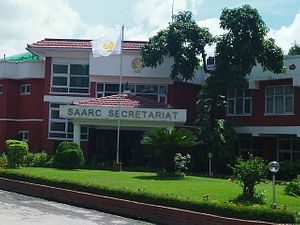What was the outcome of the 18th SAARC Summit in Kathmandu?
In a word, disappointing. The theme of the summit was “Deeper Integration for peace and prosperity.” But member countries failed to sign two major agreements on rail and road connectivity. The pact on energy, however, was signed, and will enable greater cooperation in the power sector.
The 36-point concluding Kathmandu Declaration, released on November 27, states that members will continue their efforts to intensify regional cooperation on connectivity, renew their commitment to a South Asian Economic Union, strengthen the Social Window of the SAARC Development Fund, and reiterate their commitment to free South Asia from poverty.
Why were the connectivity agreements not signed?
Three important agreements related to connectivity—the Agreement for the Regulation of Passenger and Cargo Vehicular Traffic, the SAARC Regional Agreement on Railways, and the SAARC Framework Agreement for Energy Cooperation (Electricity), were expected to be signed. The first two agreements were stalled because Pakistan held back, saying it still had to complete its “internal processes” regarding these pacts. The third, on energy, was signed.
Was any progress made on other key issues?
The focus of the meeting was on improving inter-regional connectivity, and alleviating and jointly combating issues of illiteracy, poverty, corruption, climate change, and terrorism.
Apart from limited progress on connectivity, discussions on the South Asia Free Trade Agreement (SAFTA) and the SAARC Agreement on Trade in Services (SATIS) also did not move forward substantively, except for a call for more effective and early operationalisation of these agreements.
What were the new initiatives proposed by India?
India promised to launch a satellite for the region by SAARC Day in 2016, set up a Special Purpose facility in India to finance infrastructure projects in the region, ease business visas by launching a SAARC business traveller card, and provide immediate medical visas for patients and attendants.
Prime Minister Narendra Modi also suggested that a SAARC regional Supra Reference laboratory can be established to fight the common diseases of tuberculosis and HIV in South Asia. In the field of education and research, he pledged to expand India’s high-speed broadband National Knowledge Network, which will connect universities in India to the SAARC region, in order to help disseminate information and build regional research capabilities. In addition, Modi suggested that the South Asian University, set up in 2010 in New Delhi, can develop a partnership with at least one university in each of the member states.
What is the future of SAARC after this summit?
First, the expansion of membership of SAARC will be up for discussion from now on. Pakistan called for a more prominent role for observers in the future—mostly China. Other member states like Nepal and Sri Lanka also support this, and China itself is actively seeking a greater role in SAARC. India responded by saying that economic cooperation between the existing members must be strengthened before expanding membership.
Second, the issue of connectivity must be resolved if SAARC is to be strengthened. For now, member states have agreed to a three-month extension for the approval of the two key agreements on rail and road connectivity that were stalled by Pakistan. The three connectivity agreements, if implemented, will enhance economic activity within South Asia and bring the goal of SAFTA closer.
Finally, if SAARC is to be an effective multilateral entity, India and Pakistan will have to work out their differences and play a more constructive role. All member countries must now move forward on the stated common goals before they meet again at the 19th SAARC Summit, scheduled to be held in Islamabad in 2016.
Sharmadha Srinivasan is a Junior researcher at Gateway House. She has earlier interned at Espirito Santo Securities in the capacity of an economist, and at the Institute of Economic Affairs in London as a researcher. This article was originally published at Gateway House: Indian Council on Global Relations, a foreign policy think tank in Mumbai, India, established to engage India’s leading corporations and individuals in debate and scholarship on India’s foreign policy and the nation’s role in global affairs.

































